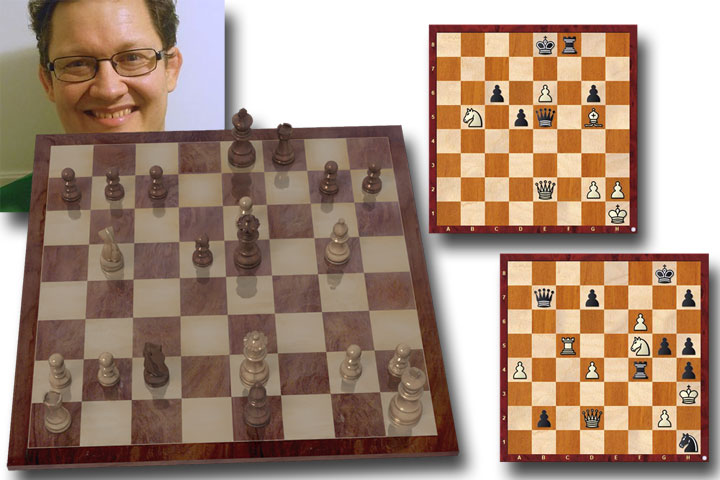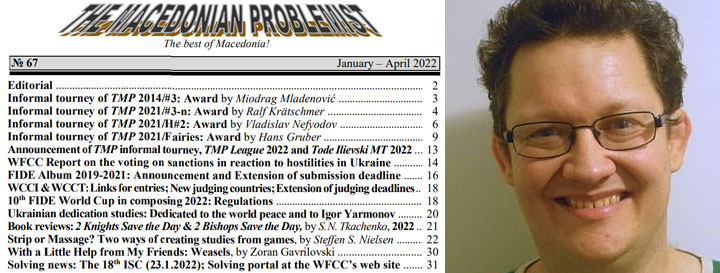



I suggest that the alternative to the established strip method [described in the previous article] should be called massage. It is best explained with an example:
Click on the notation to replay the moves
This is what Tal’s 21.h4! might look like after stripping:
You can move pieces on the board, and even start (fan icon) an engine to assist in analysis. There you can have multiple variations, and a button to display the threat of entered moves.
The diagram is the result of 10 minutes of work on my part. To make h2-h4 the only winning move, I still need 13 pieces! Of course, I could now go about creating an introduction, which inevitably would involve even more pieces. And when that was done, would h4! really be a sufficiently striking finale to merit 13 pieces on the board? The mate after 1...Qxe2 2.Sc7# would be nowhere near ideal (in either meaning of the word).
Instead of stripping, there is another route to travel, namely to stand back and try to decipher what Tal’s 21.h4 is really all about, looking at the position abstractly rather than concretely. My interpretation is that the move is fundamentally about “leaving pieces en prise and playing elsewhere”. This is no profound idea in itself, but imagine that Miller had the chance to react in a similar way, doubling the idea. Imagine he had some way to cover h2 so that the back rank would still be weak and the queen on e5 would still be immune. And imagine that Tal had a counter-counter, still leaving the queens to stare at each other in a perfect act of suspense.
I am far too unstructured to be able to retrace the steps that followed as I tried to create a study from Tal’s beautiful move. But basically I tried to turn the game brilliancy into a situation where both kings were potentially under threat of mate. Weak back ranks are perfectly suitable for creating and maintaining this kind of tension (and better suited than the threat on c7 in the game). After some months of work – where I probably ate and slept as well – I had the following study on my screen:
If you click or tap the diagram, or anywhere in the above notation, you will get a large board on which you can follow the moves of the game. Click on the fan icon to start an engine.
Notice that the final position still involves 14 pieces, which is roughly the same as after the attempt at strip shown above. The economy suffers.
The above article appeared in TMP and is reproduced with the kind permission of the author.

The Macedonian Problemist, issue no. 66 (Sep.-Dec. 2021), Steffen Slumstrup Nielsen
Editor Zoran Gavrilovski writes:
"The Macedonian Problemist" ("TMP") is a non-commercial venture. Issues with consecutive order of pages published on my Facebook page. They are also e-mailed to 150-200 recipients, are free of charge and shareable without any charge or specific consent from my side, under the proviso that these issues are not subject to purchase/sale.
Payment is only required if you wish to receive printed issues (EUR 15 for 2022, EUR 9-15 for earlier sets of annual issues, depending on the number of issues and pages per year), or PDF for the purpose of printing the issues on your own PC. For such PDFs there is 50% discount of the price mentioned above.
TMP has established itself as one of the top 20 chess composition magazines. In the last printed FIDE Album 2013-15, out of the total number of 1,499 selected chess compositions (problems and studies) there were 46 problems from TMP, which places it at the 7th place in the unofficial table/ladder of magazines or other outlets with a highest number of selected chess compositions in the FIDE Album 2013-2015, or at the 9th Place in the list of most represented sources in the FIDE Album 2013-2015. I consider the above success as outstanding, because TMP is a low-profile venture with regular involvement of a few persons other than me (notably: the proof-reader Predrag Zuvic from Croatia, the regular judge of ''TMP'' tourneys Hans Gruber, the all-time most successful chess composer Petko Petkov from Bulgaria with his excellent original problems and thematic articles, excellent language editors such as Geoff Foster from Australia and other occasional collaborators who support the magazine with free of charge assistance). The magazine has no stable financial basis, and it would be fair to say that it would have been unsustainable and defunct if it weren't for my dedicated perseverance to keep its publication throughout the years.
| Advertising |